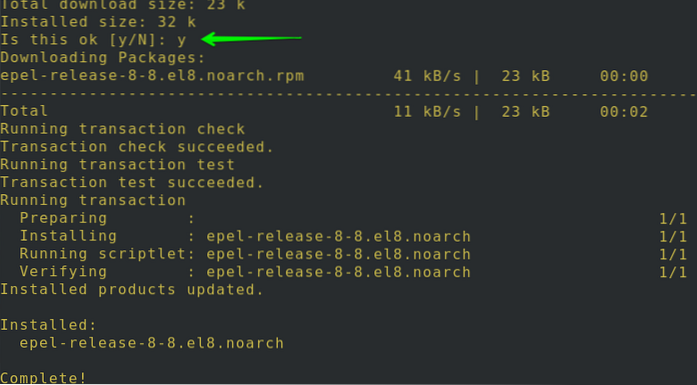The apt-get clean command helps to clean out the cache once you have installed the packages using apt-get install command in your system. It removes the files that are no longer required but are still residing on your system and keeping the system space. The apt-get command removes the retrieved .
- What is the use of APT-get clean?
- When should I run apt-get clean?
- Is apt clean dangerous?
- What is a purpose of APT-GET commands?
- How do you clean up apt-get?
- How do I remove sudo apt?
- What is sudo apt-get dist upgrade?
- What is sudo apt upgrade?
- How do I free up space on my VAR cache apt?
- How do I uninstall apt update?
- How do I remove unused packages in Linux?
- What is the difference between APT and APT-get?
- How do I know if apt packages are installed?
- What is the difference between apt-get update and upgrade?
What is the use of APT-get clean?
The apt-get clean command clears the local repository of retrieved package files that are left in /var/cache. The directories it cleans out are /var/cache/apt/archives/ and /var/cache/apt/archives/partial/. The only files it leaves in /var/cache/apt/archives are the lock file and the partial subdirectory.
When should I run apt-get clean?
The clean command clears out the local repository of downloaded package files. It removes everything except the partials folder and lock file from /var/cache/apt/archives/ . Use apt-get clean to free up disk space when necessary, or as part of regularly scheduled maintenance.
Is apt clean dangerous?
No, apt-get clean will not harm your system. The . deb packages in /var/cache/apt/archives are used by the system to install software. But once the software is installed, these .
What is a purpose of APT-GET commands?
apt-get is a command-line tool which helps in handling packages in Linux. Its main task is to retrieve the information and packages from the authenticated sources for installation, upgrade and removal of packages along with their dependencies. Here APT stands for the Advanced Packaging Tool.
How do you clean up apt-get?
The apt-get clean command helps to clean out the cache once you have installed the packages using apt-get install command in your system. It removes the files that are no longer required but are still residing on your system and keeping the system space. The apt-get command removes the retrieved .
How do I remove sudo apt?
Uninstall Applications Through the Command Line
You can remove installed software from your system through apt-get remove and apt-get purge commands as sudo.
What is sudo apt-get dist upgrade?
The apt-get dist-upgrade command intelligently handles changing dependencies with new versions of packages and will attempt to upgrade the most important packages at the expense of less important ones if necessary.
What is sudo apt upgrade?
The sudo apt-get update command is used to download package information from all configured sources. So when you run update command, it downloads the package information from the Internet. ... It is useful to get info on an updated version of packages or their dependencies.
How do I free up space on my VAR cache apt?
This page explained APT cache and how to use the clean and autoclean apt-get command that clears out the downloaded package files from/var/cache/apt/archives/ folder. In short, use the sudo apt clean and sudo apt autoclean to free up disk space as part of scheduled maintenance on your Debian or Ubuntu Linux server.
How do I uninstall apt update?
For Ubuntu the correct method to remove packages through the console is:
- apt-get –-purge remove skypeforlinux.
- dpkg –-remove skypeforlinux.
- dpkg –r packagename.deb.
- apt-get clean && apt-get autoremove. sudo apt-get -f install. ...
- #apt-get update. #dpkg –-configure -a. ...
- apt-get -u dist-upgrade.
- apt-get remove –dry-run packagename.
How do I remove unused packages in Linux?
Simply run sudo apt autoremove or sudo apt autoremove --purge in terminal. NOTE: This command will remove all unused packages (orphaned dependencies). Explicitly installed packages will remain.
What is the difference between APT and APT-get?
apt-get is one such command-line tool which is widely popular. ... apt is more structured and provides you with necessary options needed to manage packages. Bottom line: apt = most common used command options from apt-get , apt-cache and apt-config . I have written in detail on the difference between apt and apt-get.
How do I know if apt packages are installed?
How do I see what packages are installed on Ubuntu Linux?
- Open the terminal application or log in to the remote server using ssh (e.g. ssh user@sever-name )
- Run command apt list --installed to list all installed packages on Ubuntu.
- To display a list of packages satisfying certain criteria such as show matching apache2 packages, run apt list apache.
What is the difference between apt-get update and upgrade?
apt-get update updates the list of available packages and their versions, but it does not install or upgrade any packages. apt-get upgrade actually installs newer versions of the packages you have. After updating the lists, the package manager knows about available updates for the software you have installed.
 Linuxteaching
Linuxteaching



